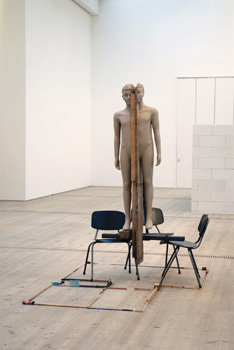Two exhibitions
dal 11/12/2008 al 21/2/2009
Segnalato da
11/12/2008
Two exhibitions
S.M.A.K. - Stedelijk Museum voor Actuele Kunst, Ghent
Mark Manders / Max Sudhues

Mark Manders
The Absence of Mark Manders
Since the end of the 1980s Mark Manders (b. 1968, Volkel, the Netherlands) has created sculptural installations – or better said: installation sculpture – which can all be regarded as sections of a self portrait in the form of imaginary spaces. Through his recent participation in the 24th Sao Paulo Biennale (1998), the Venice Biennale (2001) and Documenta 11 in Kassel (2002) Manders has acquired a prominent and autonomous position in the international world of sculptural artists.
His career began as early as 1986, the year in which he created one of the key works in his body of work, 'Self Portrait as a building'. Everything Mark Manders subsequently produced can be interpreted within this idea of the self portrait as a building and as an attempt to translate his own human existence and biographical memories and feelings into wordless associative memory spaces or –installations. This concept of the 'self' as architecture, as a building, produced an art that sees sculpture as a spatial materialising of highly personal – sometimes abstract – thoughts, feelings and emotions. Of course Mark Manders is apprehensive about not allowing his poetic 'self' to fully coincide with the real, autobiographical Mark Manders, but at the same time the latter cannot be seen completely separately. Mark Manders' installations are always about a paradoxical balance: the construction of a self-portrait which can only reveal itself in a more universal visual idiom tha t transcends the hyper-personal and is characteristic of all good contemporary art.
Together the chimneys, brick walls, larger than life rats, chairs, newspapers and a collection of small personal objects form a sort of 'still lives with broken moments', an art that appears to distance itself from time. In his work Mark Manders seeks precisely that point at which the radical personal aspect of his sculptures, most of which are made by hand, comes fully to its own but at the same time – like a radical self-portrait – also acquires a more general character.
In the ever swelling 'self' spaces of Mark Manders like this an encyclopaedia of melancholy and occasionally terrifying idea and memory –architectures of a sort of ghostly self image, gradually develop. As regards atmosphere, many of his installations are strongly linked to nineteenth-century so-called Gothic literature of which writers like Edgar Allan Poe and Alfred Kubin are the most famous adepts.
In Mark Manders' spaces, which are filled with echoes and reverberations, presence and disappearance together follow a fascinating path situated somewhere between dream and nightmare through a world full of puzzles and paradoxes.
Mark Manders' sculptures function almost as three-dimensional photos that lodge themselves in the spectator's mind through the retina where they continue to work almost as an afterimage.
Indeed the spectator himself can always recognise something in Mark Manders' sculptures, something he cannot indicate directly, but which he has already experienced, felt or thought.
The fact that Mark Manders does not thrust his installations far enough out of normality so that they become strange and familiar at the same time, makes up the real subtlety of his artistic approach in which it is not about sensation, shock effects and the grand gesture, but about a sort of precision in the field of stillness, the indeterminate and indefinable.
For this exhibition, 'The Absence of Mark Manders' – which is his most important presentation so far - Mark Manders has created new central installations and sculptures supplemented with work from the period 1990 to 2007. Several other installations on display have never been exhibited before.
---
Max Sudhues
Pluto
The installations created by Max Sudhues have an immediate charm because of their honesty and modesty. Observing his work means entering an environment that is both poetic and threatening, balancing on the verge of dreams and nightmares. In the tradition of the ‘collage’, he creates fantastic worlds where the original objects remain visible, but faded, so that a number of associative interpretations may be possible. He achieves this through transforming banal and everyday objects through light projections and to transform them to unexpected proportions and interpretations. The use of different projection methods – from office lamp to beamer – makes it possible to create various images. In an ‘obstacle course’ of installations, various projections, video loops and a great range of combined materials, Max Sudhues explores the boundaries of analogue and digital, light and shade. He refers to the apparent static state of everyday affairs, which are in reality, subject to constant change.
Each object retains its own functionality within the installation, but it is invariably connected to a bizarre, narrative and complex fantasy world. This creates various visual layers. Behind the trusted run-of-the-mill foreground, Max Sudhues searches for moments of confusion and alienation, for apparitions that may try to ‘break open’ a normal perception.
Max Sudhues (1977, Münster) studied at the Münster Art School and afterwards continued his artistic training in Frankfurt and Ghent (HISK, 2006-2007).
Image: Mark Manders, Unfired Clay Figure, 2005-06. Commissioned by the BALTIC Centre for Contemporary Art, Gateshed / Dakis Joannou / Collection Athens
Press officer Els Wuyts mail: els.wuyts@gent.be
Opening 12.12.2008
S.M.A.K.
Citadelpark - 9000, Ghent Belgium



